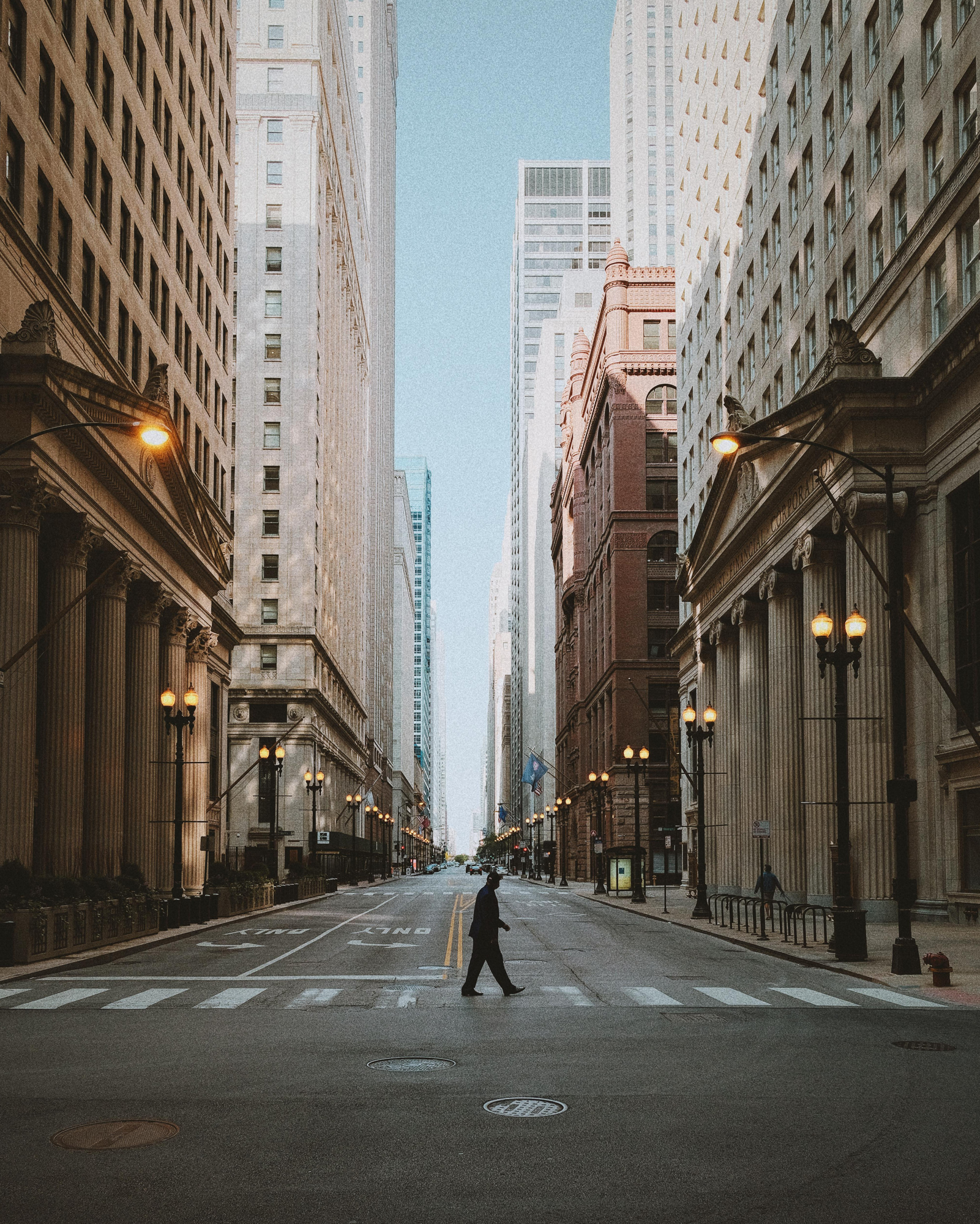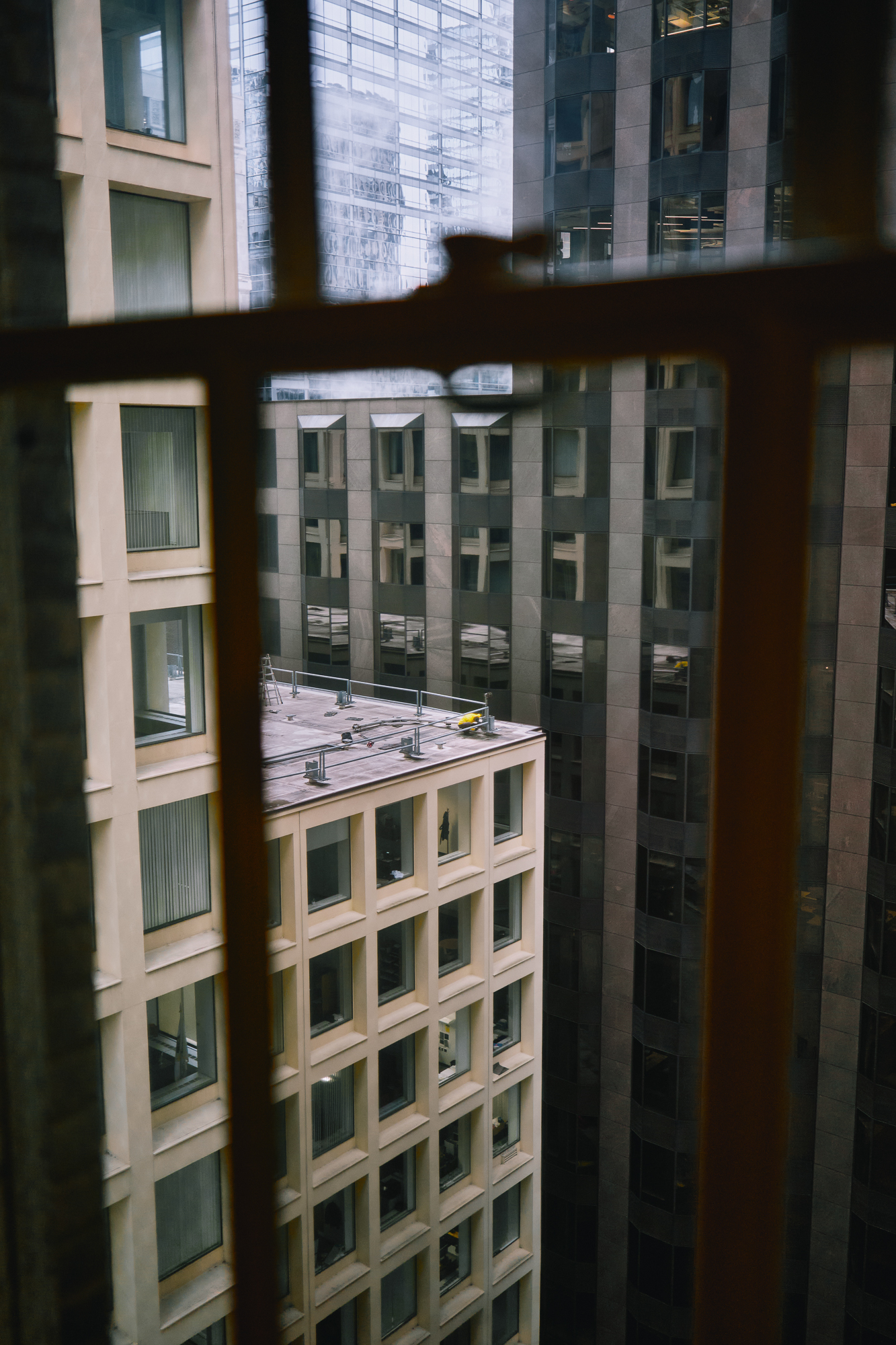Street Photography of Absence
This post originally went out as part of my newsletter, Monochromatic Aberration. Subscribe now to be the first to get posts like this.
I would consider my work generally "people-focused." This isn't some grand theory of art, mind you: "people-focused" vs. "nature-focused" or "idea-focused," or something.
I think this is most obvious in my photos. Even in some of the emptiest, there is almost always a person present. Like this one of downtown Chicago:

I love not only the sense of scale it offers, but the connection formed between myself and a subject, a viewer and a subject; however tenuous or fleeting. It's hard for me to look at this and not remember the moment I made the photo, of course, but also imagine myself walking, gazing up at the tall buildings. I think I do that anyways; looking up into the windows, lit or not, imagining the people who are in there, working or living, what they might be thinking.
Sometimes I take photos from those window perspectives, like this one from the same area:

There's lots of these little places on buildings downtown, which for some reason seem inaccessible, but of course, they're not. I don't even really want to be out there, personally; I'd probably go if I knew it would be safe, but I don't love heights! But the buildings and their little nooks and balconies only interest me in the idea that a person could be there.
Writing this now, I wonder if this is part of the reason architectural photography has always seemed a lot easier for me than landscape photography—the people are already implicitly present. (Note to self: I should challenge myself to make more landscape photos).
With this, it's hard for me to not think of an incredible interview between author Miyazawa Iori and Mizoguchi Rikimaru from Hayakawa Books, an editor from the imprint that publishes their books. Miyazawa's most famous novel series is called Otherside Picnic, which is a yuri reimagining of the novel Roadside Picnic (which was adapted into the Tarkovsky film Stalker). Yuri is a genre that focuses on female same-sex relationships. This interview was translated into English by @Kati_Lilian, and made the rounds on twitter for a fascinating point Miyazawa makes.
He describes a burgeoning concept he calls "yuri of absence." "That is, emotional scenery is already yuri," says Miyazawa. He continues:
"A cliff is towering over the sea, grass is growing on top of it, there is a fence, the gray ocean and sky are stretching beyond the horizon, there is an empty bench for two... Someone was uploading these images with a "#yuri" tag. You can totally get that."
Mizoguchi: "So it's like the cover of chapter 9 of "Otherside Picnic", where the two girls ride on a farming vehicle, and a boundless meadow is around them... You're saying this is yuri."
Miyazawa: "Yes. Now remove both girls from this scenery."
Mizoguchi: "Right."
Miyazawa: "A rusty, decaying vehicle is resting on top of wheel tracks."
Mizoguchi: "Right."
Miyazawa: "Then you imagine that one day two girls were there... Isn't that already totally yuri?"
Mizoguchi: "Right..."
Miyazawa: "So a grassland somehow becomes yuri."
I shared some photos on twitter recently sort of in this vein.
人気#Fujifilm #streetphotography #photography #Chicago pic.twitter.com/zHLNp0nZDH
— イアン (@IanJBattaglia) February 27, 2023
I never know what to title or caption my work, and actually resist doing so whenever I can for fear of coloring a viewer's impression, but this time I chose a Japanese word. This word is almost always read as "ninki," which means popular, but it can also be read as "hitoke," meaning "signs of life." Just a couple of snapshots with people, that's not necessarily of people.
It's funny thinking about this, the subject or character focus or at least the felt absence of one, and thinking about some of my most vivid memories. I'm not even really sure that "memories" is the right term; they might just be my "imaginings."
Sometimes, when I'm daydreaming or dozing off, I call to mind these little scenes in my head. Places I've been, often little corners from the town I grew up in. I've always had a really visual, active mind; I think in sentences, I can imagine a room I read about in a book, that sort of thing.
They're little places that might have no significance for anyone but me—but for me they're strangely evocative. Mostly I imagine places at night; maybe that makes it easier, if everything falls off into darkness—sort of like limiting the "draw distance" on a video game.
For example, I can vividly call to mind the park area outside my hometown's community center. It's night, of course. It's a big park, and I can imagine the sledding hill, with the soccer fields I played at on the other side—but the part that comes to mind first is a small strip of grass and trees between the community center and the closest residential block. I'm not exactly in the scene, per say, but my perspective is sort of by default facing the same way, towards the houses. One of my friends lived in a house a few blocks towards that direction. I know the large glass window into the pool is behind me. And it's snowing.
How many times would I have been there, at night, in the streetlamp-lit snow? Maybe a couple? Yet this scene is immediately accessible for me.
Another is on the coast of Lake Michigan, in a town my family used to go to on vacations. It's a small park above a beach, with a playground, all of which sits out back of a restaurant we ate breakfast at most days. It doesn't look like that anymore; I went back not too long ago, and I couldn't help but think going to that park was somehow the purpose of my trip. Maybe checking on it. (The community center is different now, too).
These are just examples, but I've got a whole backlog of these sorts of places, that live on as one of those looping cinemagraphs in my mind. (And like I said, they're not all strictly nostalgic places.)
I guess all this to say: while it's difficult for me to imagine a "street photography of absence,"
- Maybe I should be pushing myself to try. After all, if I can see a simple scene as part of a relationship-focused narrative genre like yuri, why couldn't the same be true for a subject-focused genre like street photography? And:
- Even if I can't or simply don't come up with any concept of a "street photography of absence" anytime soon, this sort of pull towards evocative scenery has come up in other parts of my work, even across mediums.
For example, thinking about the park outside the public pool precipitated in a short story I'm working on. While the story itself is extremely character-focused, the part that struck me, that got me writing, and became the setting for the story at large and the most climactic scene is the area around the pool. Hope I can share it with you all sometime.
If you liked this post, please consider subscribing to my newsletter, Monochromatic Aberration, at that link or using the button near the bottom of your screen. I write about photograph, writing, and trying to live an examined life. Your support means a lot.
